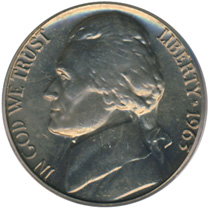
During the course of the series, the Jefferson Nickel was struck in two different compositions. The first composition was the standard alloy used since the introduction of the denomination in 1866, while the second was used during World War II in an effort to preserve nickel and copper.
The original composition consisted of 75% copper and 25% nickel. The weight of Uncirculated pieces is 5 grams, or 77.19 grains, with a diameter of 21.2 mm and a plain edge. These specifications apply to coins struck from 1938 to 1942, and 1946 to present. The mint mark originally appeared on the reverse, to the right of Monticello. Starting in 1968, the mint mark was moved to the obverse, beneath the date.
From October 1942 until the end of 1945, a composition consisting of 56% copper, 35% silver and 9% manganese was used. The weight and diameter of the coins remained the same. The mintmark location was moved to the reverse of the coin above Monticello, where it appeared in larger size. This brief run represented the first time the five cent denomination contained silver since 1873.
Frequently Asked Questions
The Jefferson Nickel has been struck by the U.S. Mint since 1938.
The metal content of the Jefferson Nickel is 75% copper and 25% nickel. From 1942 to 1945, the metal content of the Jefferson Nickel was 56% copper, 35% silver, and 9% manganese.
The Jefferson Nickel’s weight is 5 grams.
The diameter of the Jefferson Nickel is 0.8346 inches (21.20 mm).
The Jefferson Nickel was originally designed by Felix Schlag in 1938. For the 2004 Westward Journey Jefferson Nickels, the Peace Medal reverse was designed by Norman E. Nemeth, and the Keelboat reverse was designed by Al Maletsky. For the 2005 Westward Journey Jefferson Nickels, the American Bison reverse was designed by Jamie Franki, and the Ocean in View reverse was designed by Joe Fitzgerald. In 2005, the Jefferson Nickel’s obverse was redesigned by Joe Fitzgerald.

